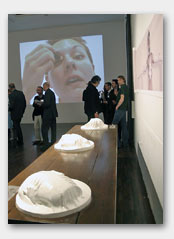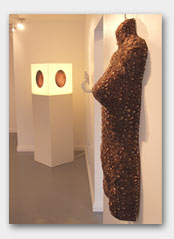Interview by Hannah Johnson, BA Fine Art at De Montfort University
I want to try to communicate what it is to be in and of a body, a female body. I say ‘female’ and that suggests a gendered body. A ‘woman’s body’ with all the layers of gendered entrapment, both by myself and by outside influences. I would like viewers of the work to experience something common whether they are female or male. I appreciate each viewer would bring something individual to the work based upon their own experiences and prejudices, so they would take something very unique away with them, perhaps even something that I did not intend. This is where it gets interesting though as then I am learning from my audience and it becomes a conversation as opposed to me ‘preaching’ to viewers about my opinions and feelings. A recent piece ‘Purge’ presented a series of videos of me performing to camera, eating communion wafers and running, slowed down in edit as if dreamlike. This piece was installed behind a wall and viewers were invited to kneel on cushions and look through keyholes to view the videos, this has brought up a lot of ideas around controlling the audience physically and has very interesting results into whether they want to ‘conform’ to a set of rules in order to view the artwork.
2) What is the relationship of your art work to ‘reality’?
Everything I make, draw, sculpt or film is my response to something ‘real’ so in that sense I guess it is all related to reality. I appreciate it is my subjective reality as everyone has different experiences depending on their age, gender, ethnicity, cultural background. I remember meeting someone who said that they felt I had summed up their pain experienced throughout an illness which affected their spine in the piece entitled ‘Going That Same Way’ and when something like that happens, it is quite overwhelming.
3) What lead you/ inspired you to become an artist?
I always wanted to draw. From a very early age I would draw everything I saw, especially things I found strange in nature, the body and other people. I am fascinated by the silent conversation you can have with someone through making art and what it can offer other people. Above all, I find the making process incredibly cathartic and I am not sure where I would be if I didn’t make ‘stuff’.
4) Do you work alone, or do you collaborate with others? Do you have staff?
I like to hide away and find my own inspiration for the work. The making process often requires other people’s help, for example of I need a cast of my own body or need someone to hold the video camera. Specialist metalworkers are my best friends too! So I commission other people rather than ‘employ’ them. When I do workshops for young people, I usually collaborate with other artists as it offers a variety of approaches to the group.
5) Is it important for you to follow a specific procedure in creating artwork?
Yes, I always have more than one piece on the go, usually at least 3. I always work from drawings, particularly the sculptural work. Although working on more than piece at a time, I see them as related so they produce a body of work.
6) Why do you choose to use un-traditional materials such as chocolate and soap within your 3D practice?
I like the idea that the work is transient, like the body. I have a growing feeling that if I make lots of ‘stuff’ which lasts too long then I am taking up valuable space in the world. I have been told that this will work against me as ‘collectors’ want work to last and it’s value will depreciate if it doesn’t. However, the process of working with materials such as chocolate, soap etc are very physical and relate to the body so perfectly that I am not sure what else could fill that. Commissioned work I complete always has the stipulation that it must last for a certain amount of time and be weatherproof, this is a challenge for me and this is when I tend to re-use found objects instead.
7) Femininity, feminism, individual control, consumption and the body are some of the reoccurring themes of your practice, how have these areas affected you within your life?
I have always struggled with the term ‘feminine’ as I don’t think I am or ever have been. I am a feminist and found myself at a very early age getting frustrated with comments, images and prejudices some people have about women. Consumption of media images of what is considered to be beautiful and of food became the primary issues in my life and my work. I have always and a disordered relationship with food and my own body however the making of artwork seems to be the solution to this. I have enjoyed researching with other people who have experienced similar things and am currently working towards Phd study surrounding this.
8) What would you say are the main feminist issues you address within your work?
The main issues I attempt to address are the pressures put upon women to look a certain way, to be a certain size and to not take up much space. This is obviously culturally dependent as what is considered ‘beautiful’ differs tremendously across the world.
9) One of my favourite pieces is ‘dirty cow, 1996’, what is the concept behind this piece?
This was a very early piece created with the idea that a woman can be labelled depending on her promiscuity. As I am now quite a bit older and wiser (I hope) and feel incredibly proud to be a woman in every sense and the image of a woman’s sexual organs appears throughout the work in all it’s sculptural form, power and ability to seduce, offend and devour.
10) What is your opinion of how women are portrayed within society and media?
In my opinion, there are not enough strong female role models within society/media who are revered for their intellect, knowledge, skill, power, etc as those that seem to be ‘on show’ constantly are those who are pinned up as an ideal. As a realist however, I appreciate there is and always will be a market for the pornographic image both of women and men. However the idea that this filters into a mainstream media image and therefore the conscience of the wider society instills fear in me. If I have children, a daughter particularly, I would be afraid for her being subjected to images of subjected women. I currently produce my artwork in a rural farm in Cataluyna with ample space and light. This rural location has no mains electric, no running water and therefore no television and more importantly no adverts. I have also stayed in Cyprus for a couple of years previous to this where I have the same setup. This is a personal choice, I must add. The choice not to pick up a magazine with the photoshopped images of unattainable beauty. Not to turn on a television and be bombarded with images of dangerously underweight women’s bodies. I do however have the internet and this is my connection to the outside world while I am creating my work, offering me a chance to get my work ‘out there’ and to see if it has any effect at all.








